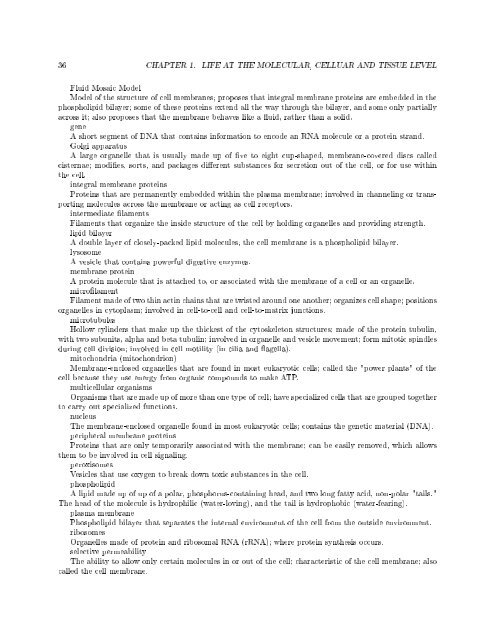Siyavula: Life Sciences Grade 10 - Cd3wd.com
Siyavula: Life Sciences Grade 10 - Cd3wd.com
Siyavula: Life Sciences Grade 10 - Cd3wd.com
Create successful ePaper yourself
Turn your PDF publications into a flip-book with our unique Google optimized e-Paper software.
36 CHAPTER 1. LIFE AT THE MOLECULAR, CELLUAR AND TISSUE LEVELFluid Mosaic ModelModel of the structure of cell membranes; proposes that integral membrane proteins are embedded in thephospholipid bilayer; some of these proteins extend all the way through the bilayer, and some only partiallyacross it; also proposes that the membrane behaves like a uid, rather than a solid.geneA short segment of DNA that contains information to encode an RNA molecule or a protein strand.Golgi apparatusA large organelle that is usually made up of ve to eight cup-shaped, membrane-covered discs calledcisternae; modies, sorts, and packages dierent substances for secretion out of the cell, or for use withinthe cell.integral membrane proteinsProteins that are permanently embedded within the plasma membrane; involved in channeling or transportingmolecules across the membrane or acting as cell receptors.intermediate lamentsFilaments that organize the inside structure of the cell by holding organelles and providing strength.lipid bilayerA double layer of closely-packed lipid molecules; the cell membrane is a phospholipid bilayer.lysosomeA vesicle that contains powerful digestive enzymes.membrane proteinA protein molecule that is attached to, or associated with the membrane of a cell or an organelle.microlamentFilament made of two thin actin chains that are twisted around one another; organizes cell shape; positionsorganelles in cytoplasm; involved in cell-to-cell and cell-to-matrix junctions.microtubulesHollow cylinders that make up the thickest of the cytoskeleton structures; made of the protein tubulin,with two subunits, alpha and beta tubulin; involved in organelle and vesicle movement; form mitotic spindlesduring cell division; involved in cell motility (in cilia and agella).mitochondria (mitochondrion)Membrane-enclosed organelles that are found in most eukaryotic cells; called the "power plants" of thecell because they use energy from organic <strong>com</strong>pounds to make ATP.multicellular organismsOrganisms that are made up of more than one type of cell; have specialized cells that are grouped togetherto carry out specialized functions.nucleusThe membrane-enclosed organelle found in most eukaryotic cells; contains the genetic material (DNA).peripheral membrane proteinsProteins that are only temporarily associated with the membrane; can be easily removed, which allowsthem to be involved in cell signaling.peroxisomesVesicles that use oxygen to break down toxic substances in the cell.phospholipidA lipid made up of up of a polar, phosphorus-containing head, and two long fatty acid, non-polar "tails."The head of the molecule is hydrophilic (water-loving), and the tail is hydrophobic (water-fearing).plasma membranePhospholipid bilayer that separates the internal environment of the cell from the outside environment.ribosomesOrganelles made of protein and ribosomal RNA (rRNA); where protein synthesis occurs.selective permeabilityThe ability to allow only certain molecules in or out of the cell; characteristic of the cell membrane; alsocalled the cell membrane.




![Mum, int. [man] - Cd3wd.com](https://img.yumpu.com/51564724/1/190x134/mum-int-man-cd3wdcom.jpg?quality=85)











